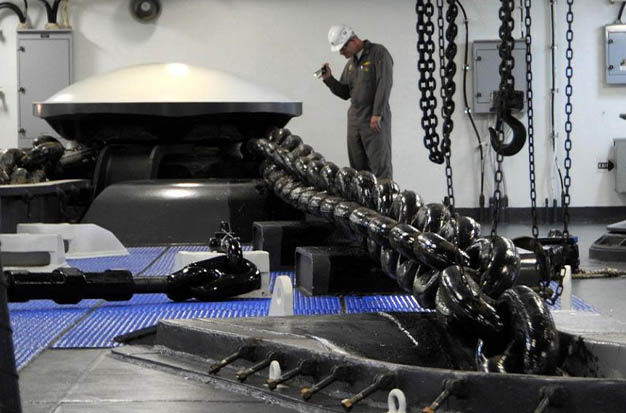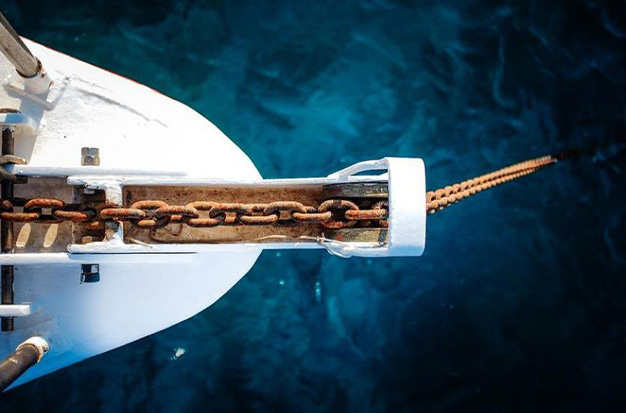How much chain should you let out when anchoring? In most conditions with an all-chain rode, for a secure overnight anchorage, you will need to let out four to five times the total of depth at high tide plus the height of the anchor roller from the water to get the correct scope. A three-to-one ratio is suitable for a “lunch hook,” where the boat is anchored for a brief period of time but is not left unattended.
Although it doesn’t cover all conditions, this is appropriate for the majority of them. The number of boats in an anchorage, local laws, and the predicted weather can all have an impact on how much chain you ultimately decide to let out.
Table of Contents
The Length Of Anchor Chain For Different Conditions
The chain to overall anchoring depth ratio is known as the scope. What ratio then should you employ?
- Typically: 4 to 5 times the complete anchoring depth
- Lunch hook: 3 times the complete anchoring depth
- Bad weather: 5 to 7 times the complete anchoring depth
If the anchorage is congested or has limited space, use a smaller scope.
The complete anchoring depth is the total depth at high tide + the height of the anchor roller from the waterline.
How Do You Measure The Amount Of Chain That Has Been Let Out?
A really nice feature on some contemporary boats is a digital chain counter. Nevertheless, a lot of boats don’t. We strongly advise affixing markers to the chain to denote different lengths, such as every 10 meters. Plastic inserts can be used for this, but many people simply use different marine-grade paint colors or even paint stripes, one for every 10 meters (1 stripe at 10 m, 2 stripes at 20 m, etc.).
Use your boat’s length as a measuring tool if you are certain that you dropped the anchor next to another boat. If the depth were 30 feet, you would need to let out 110 feet of chain (50 + 2 x 30), and if your boat is 30 feet long, then three boat lengths when you apply a 1/2 reverse throttle will roughly satisfy your formula. Consider snorkeling the anchor once it has been set to gain practice and confidence with this idea. When a gust of wind comes through, check how much chain is on the ground.![]()
Calculating Complete Anchoring Depth
Putting the proper formula down on paper was the most difficult aspect of word problems in math class. I can just give you the formulas since this isn’t an algebra class. Your target anchoring depth, expressed as a formula, should be:
Complete Anchoring Depth = Current Depth + Depth Increase to High Tide + Height of Anchor Roller
Calculating Depth Increase Too High Tide
The Depth Increase to High Tide can be a little more complex, but you will get good at estimating it with time and a conservative estimate is sufficient.
Depth Increase to High Tide = (Hours From High Tide / Length Between Tides) * Tidal Swing
- Take the height of the highest tide and deduct the height of the lowest tide from a tide table. You will then know the tide’s “swing” for the day.
- Calculate the time between high and low tides as well as the distance you are from the most recent or upcoming high tide, whichever is closer.
- How far along in the tide change you are can be calculated by dividing the time from the closest high by the time between tides.
- To determine how much the tide will rise while you are at anchor, multiply that by the tidal swing.
- When you are anchoring and can see exposed pilings or rocks on land, you can quickly determine how much the tide will inundate without using a tide table or any math if the marine growth that is visible on them is present. Just make sure you’re looking at a rock that the high tide won’t completely cover.
If you anchor in twenty feet of water at low tide, the tide will rise five feet at high tide, and your bow roller is four feet above the water, the equation is (20 feet of depth plus 5 feet of tide plus 4 feet of bow height) + 4 feet of bow height = 29. A chain length of between 116 and 145 feet is needed for a reliable anchor when multiplied by four or five.

Why Do You Need This Much?
The majority of the holding power in an all-chain rode comes from the weight of the chain.
However, the weight and friction of the chain against the bottom are what holds the boat in place most of the time, not the anchor, which prevents the chain from dragging. The majority of the boat’s weight is supported by the chain, so the boat shouldn’t pull directly on the anchor. It will not hold.
If the boat is pulling on the anchor and there is not enough chain, the anchor may not lie flat on the bottom, which will prevent the flukes and plows from sinking into the bottom as intended.
Additionally, if there isn’t enough chain to allow the anchor to lie flat due to the boat swinging or the tide or wind changing the heading, the anchor might not reset correctly. If there is enough scope, the anchor might not reset if the wind direction changes.
In areas with greater tidal swings, you cannot disregard the tide. In some of the places we’ve been, we’ve seen tidal swings of up to sixteen feet. If you didn’t include this, at a 5:1 scope, you might fall 80 feet short of the necessary chain. You might come up short in shallow water even with a three-foot tide.
When You Might Need Or Want Less?
There are situations where less chain is required.
In Crowded Anchorages
You might not have enough room to let out more chains in heavily populated anchorages without running afoul of other boats. It is acceptable to inquire about the amount of available rode from another skipper in a crowd. If the wind swings through the compass, you need to calculate the size of the circle your boat will make and where it will position itself in relation to the other boats. If you chain yourself to a number of boats and use rope or chain rods to anchor, your swing will be different from those of the boats nearby. In order to avoid falling within their wider swing radius, you might want to shorten the chain.
Anchorages With Restricted Space
Even though there is plenty of open space nearby, anchorages with limited space may require you to stay within buoyed-off areas and keep your scope short. One of the harbors we anchored in had a small wedge-shaped anchorage marked on the charts, but the designated anchorage was also encroached upon by a mooring field. The area was strictly enforced by the local navy, who would remove you if you crossed a line marked by pilings. We positioned ourselves with a three-to-one scope on the edge of the mooring field to prevent us from swinging into the moored boats in a southerly or the restricted area in a northerly direction.
Lunch Hook
Additionally, if you have a manual windlass and have to haul all that chain back on board after lunch and a quick swim, you don’t need to bunker down like you’re expecting a storm if you are only stopping for a short while. It is simpler to set a shorter scope when the weather is calm and you don’t intend to leave your boat or spend the night there.
Common Anchor Chain Mistakes
When determining how much scope they need to anchor securely, many boaters ignore important pieces of information.
One common mistake is to use the current depth of the water beneath the boat at the time they drop the anchor.
Another mistake is not including the height of the anchor roller above the water. You won’t have enough chain for safety and comfort if either of those factors is overlooked.
One other error boaters make is not measuring how much chain they have put out. It can be challenging to gauge how much chain is racing out of the anchor locker by eye, and it’s simple to release more or less than you actually have. It’s risky to use accurate math but inaccurate measurements.
It’s crucial to have a way of measuring how much chain you have down. Alternatively, you can mark your chain to indicate distances as it travels out instead of installing a mechanical or electronic chain counter. Choose a method that is as close to permanent as you can because most chain markers fade or wear off.
Considerations
There will always be some balancing decisions to be made regarding how much rode to let out, whether the chain is just chain or chain and rode. When making your choice, take into account the following:
- The harbor is crowded
- Some boats may be using all chains (and thus less swing)
- Your own swing circle
- Predicted night wind shifts and strengths
- Tidal change
- The amount of chain before rope on your rode
- The closeness to shore or underwater rocks inside my swing
- The type of bottom
Because of all these things, it is recommended that, if you can, you snorkel over your anchor to make sure it is properly positioned and dug in before you go to bed or leave the boat. In addition, you should set multiple time alarms, a GPS anchor alarm, a depth-change alarm, and alarms to wake you up several times during the night to check.
Conclusion
Your rod keeps you fastened to your anchor, so it’s critical to choose one that can support your boat and is sturdy enough to withstand any weather you encounter. Once you’ve correctly installed your anchor rode, it should give you years of dependable service.
![]() It’s just as crucial to check the weather for your anchorage as it is for your voyage. An anchor can become unsettled by sudden changes in wind direction as the boat swings and the anchor loads. When choosing where to anchor, comfort is a factor. A nighttime wind shift could make an anchorage that was previously comfortable uncomfortable. However, when that occurs, it becomes dangerous because you don’t have enough scope to hold you.
It’s just as crucial to check the weather for your anchorage as it is for your voyage. An anchor can become unsettled by sudden changes in wind direction as the boat swings and the anchor loads. When choosing where to anchor, comfort is a factor. A nighttime wind shift could make an anchorage that was previously comfortable uncomfortable. However, when that occurs, it becomes dangerous because you don’t have enough scope to hold you.




